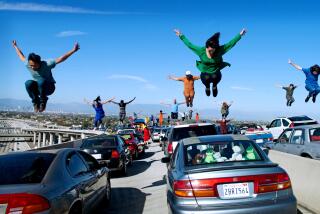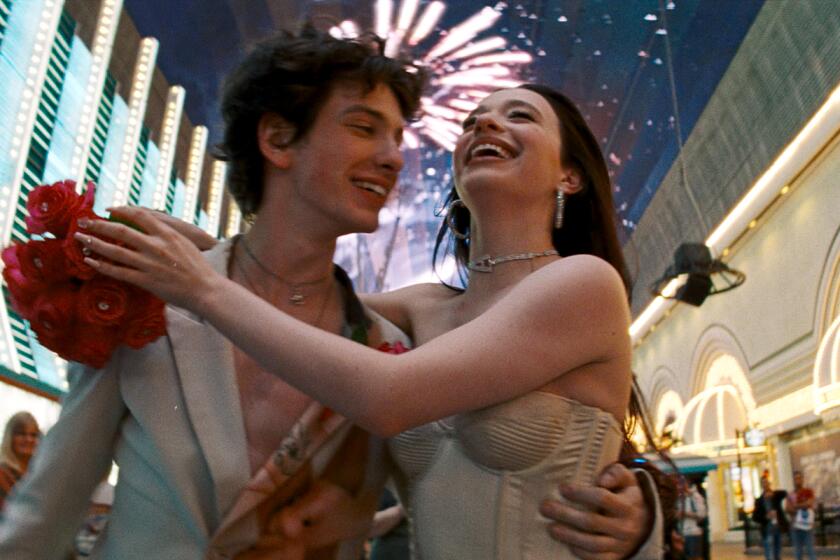Live, in Costa Mesa . . . the Oscars?
- Share via
Word spread rapidly late last week that, because of logistic problems at the Shrine Auditorium and the Dorothy Chandler Pavilion, the venerable Oscar ceremony may be moved to Long Beach or Costa Mesa in 1999. The awards event, in its 69-year history, has never been held outside the immediate Los Angeles area.
Long Beach is about 25 miles from downtown L.A. and Costa Mesa nearly 20 miles farther.
Although the Academy of Motion Picture Arts and Sciences emphasized that no decision will be made until fall, few in the film community seemed reassured.
Typical of the reactions: “I do not think that Hollywood wants to go to Long Beach or Costa Mesa,” said Dale Olson, who serves on the public relations committee of the academy and does publicity for Shirley MacLaine and James Earl Jones. “People who normally buy tickets won’t. . . . It’s insane.”
“Moving the Oscars would be the end of an era,” said veteran publicist Warren Cowan. He laid the blame on television. “The TV contract is so important that they need a larger venue to handle requests from all the sponsors and networks--in addition to the 5,000 members of the academy and international press,” he said.
Space is only one of the issues, according to academy executive director Bruce Davis, who last week led a scouting expedition to the Orange County Performing Arts Center and the Terrace Theater at the Long Beach Convention & Entertainment Center.
Davis said the two venues under consideration had about roughly the same seating capacity as the 2,800-seat Dorothy Chandler Pavilion (the Shrine, by contrast, has about double that many).
The problem with the Dorothy Chandler is more about booking the space early enough to provide enough rehearsal time.
“We’re more concerned with the fact that, because of the L.A. Philharmonic schedule, we can’t get into the Dorothy Chandler two weeks before the Oscars,” Davis said. That could change if the proposed Disney Hall ever gets built because the Philharmonic would move there.
The Shrine problems include poor crowd flow within the building--particularly at arrival and exiting time, creating a logjam at the post-award Governor’s Ball, he said.
At both facilities, there is insufficient space for the press to interview winners after they come offstage. At the Music Center, stars have to take an elevator up four floors to get to the press. At the Shrine, the academy must set up a tent.
Neither Long Beach nor Costa Mesa lobbied to get the awards ceremony, according to Davis. The academy was just seeking to gain “firsthand familiarity” with the two alternative facilities that had been under discussion for years, he said.
However, now that the news has broken, both cities plan to take an activist approach.
On Friday, David Gordon, general manager of the Long Beach Convention Center, said that the city was “absolutely” going to take action to get the Oscars. And Judith O’Dea Morr, programming director at OCPAC, was equally adamant. “If there’s something we can do to help [bring the Oscars to] Orange County, we’ll work with them to make it happen,” she said.
As Davis sees it, the Long Beach facility has a number of pluses. It’s adjacent to a convention center so large that it could hold not only a Governor’s Ball but “a circus and a rodeo at the same time.” On the downside, the size of the stage is small.
As for Costa Mesa, it has a “fabulous” look outside, Davis said. Its dramatic architecture has provided a focus for Orange County musical events.
But, then, of course, there’s the distance. . . .
That trek down the freeway, some prominent managers and publicists suggest, would make a bad situation worse. No matter that the broadcast would be switched from Monday to Sunday night to minimize rush-hour traffic problems, according to Davis.
“Are they going to install a helipad?” asked Brad Grey, chairman of the Brillstein-Grey Co., which manages stars such as Nicolas Cage, Brad Pitt and Christian Slater. “That’s the only way people would be less upset.”
Pat Kingsley, a principal in the PMK public relations agency, predicted that a lot of stars would bail out if a move were made. Already, she said, unless actors are nominated or presenters, they generally choose not to go. “There could be even more defections with all that additional driving time,” she said.
Kingsley also predicted that attendance at after-Oscar parties would drop. “Since this isn’t a late-night town, you’d probably lose on both ends,” she said.
Olson said he expected the Governor’s Ball to be the hardest hit. “Folks coming by limo might stop by for a drink,” he said. “But if, like most people, you arrive by car, you don’t want to drink there and drive home all that way.”
A move south is bound to create ripples, said Leonard Schwartz, a managing partner at Maple Drive restaurant, which has hosted the Academy Award viewing party to benefit the Elton John AIDS Foundation for the past four years.
“I would hope that Elton would still choose to have the party at Maple Drive,” he said. “People might arrive that much later or choose to spend the whole night over dinner with us. In the end, though, I’m guessing that the academy will be sensitive to people’s needs.”
All these concerns will be taken into account, Davis said. And, since the academy is committed to the Shrine for 1998, there’s time to work things out. Talks with the Shrine and the Dorothy Chandler are still ongoing. The Board of Governors will begin discussions this summer.
“We have a strong preference to do the Oscars in L.A. . . . It’s clear we’re not taking the show to Memphis or to New York,” Davis said. “But given our need for a glamorous setting with adequate rehearsal time, Greater L.A. may be close enough.”
More to Read
The biggest entertainment stories
Get our big stories about Hollywood, film, television, music, arts, culture and more right in your inbox as soon as they publish.
You may occasionally receive promotional content from the Los Angeles Times.










